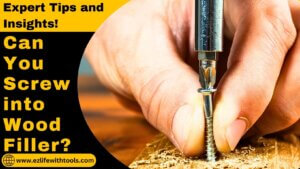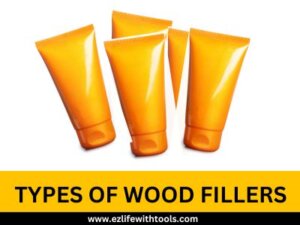Can You Screw into Wood Filler? Expert Tips and Insights!

Can you really screw into wood filler? It is a question that arises in your mind when you are going to repair, protect or modify wooden projects. The compatibility between screws and wood fillers is not always straightforward.
In this article, The main focus is to explain the methods that are involved in trying to penetrate wood fillers to understand can you screw into wood filler.
Let’s explore the possibilities and limitations together.
What is a Wood Filler?
Wood filler is a versatile material which is used to repair imperfections in wood surfaces, which raises questions about its compatibility with screws.
It is important to know first what are the basic principles of wood filler composition and its relationship with screws.
Composition of Wood Filler
Wood fillers are available in different types that are manufactured using wood fibers, binders and additives. The main purpose of these wood fillers is to fill gaps, cracks or voids in wood to create the same texture and color of the wood surface.
However, the structural integrity and adhesive properties of wood filler differ significantly from the properties of wood. But it plays an admirable role in filling the wood holes.
Screw Compatibility with Wood Filler
The ability to secure screws to wood filler depends on various factors. Wood fillers structure has less ability to hold the screw firmly than a natural wood structure. Therefore, it often creates uncertainty about the filler’s ability to hold the screw securely.
Can Drilling Holes in Wood Filler Produce Successful Results?
Drilling holes in wood filler is a different topic and has a couple of challenges.
Although drilling in wood filler may seem possible at first, it is possible that the wood filler may not provide the required resistance and support because there is a huge difference between solid wood and wood filler to hold the screws securely.
Understanding the importance between wood filler and natural wood is important to evaluate whether screws can be effectively embedded in the wood filler.
It is a complex balance between the composition of the filler, the type of screw used, and the load or stress expected from the screw.
Factors Affecting Screw Capacity
The ability of wood filler to patch effectively can be affected by several factors.
These are some considerations; the success or failure of secure patches depends on these factors.
- Effect of Air Bubbles in Screw Holding: Trapped air bubbles within wood filler can damage its structural integrity. Air bubbles can reduce the required density and strength of wood filler to provide support which will cause loose screws or wear out over time.
- Matching Screw Types with Wood Filler: Choosing the right type of screws is important when working with wood filler. Some screws, like self-tapping or self-drilling variants, have better success to penetrate in certain types of wood filler. Therefore, it is necessary to understand the compatibility between screw threads and filler material, which will improve the chances of secure attachment.
- Load Size and its Effect on Screw Hold: The load or tension placed on the screw is also an important factor in determining the suitability of screwing into wood filler. Exceeding the filler’s load capacity by applying excessive force or load to the screw can cause instability, and the screw can be pulled out or weaken the surrounding filler material.
Types of Wood Fillers to Screw into Wood Filler
Different wood fillers present different properties that can affect their ability to hold screws effectively.

- Water-Based Wood Fillers
- Petroleum-Based Wood Fillers
- Epoxy Wood Fillers
- Bondo Wood Filler
- Elmer’s Wood Filler
Evaluating the suitability of different wood fillers
1- Water-Based Wood Fillers
These fillers, made of water and cellulose-based materials, are more flexible when dry. Although they have the ability to hold the screws to a certain extent, their flexibility can compromise long-term screw stability.
2- Petroleum-Based Wood Fillers
These fillers, using solvents such as lacquer or epoxy, often dry to a hard consistency. This increased stiffness can provide better support for the screws, but there is still a chance of failure due to possible breakage.
3- Epoxy Wood Fillers
They are very famous due to their exceptional hardness and durability when dry; epoxy fillers securely hold the screws. Their specifications make them the preferred choice when considering screw applications.
4- Bondo Wood Filler
Bondo fillers are also very famous, and they provide strong and durable results, but their flexibility can affect the stability of long-term screws.
5- Elmer’s Wood Filler
Elmer’s Fillers consist of water-based materials, and they are usually used to provide moderate support for screws. Therefore, you can use it only in places where less tension is applied to the screw.
Apply Wood Filler to Secure Screws
The process consists of several sequential steps to ensure maximum support for the patch where the wood filler is filled.
Surface Preparation for Effective Application
First, make sure that the wood surface is clean, free of debris and completely dry. Any moisture or contamination can hinder the bond of the filler, which can affect the wood filler’s ability to hold the screw.
If there is an old filler in the area where the new patch is to be placed, remove it also to create a clean foundation for the new filler application.
How Can You Screw into Wood Filler Step-by-Step
Here is step-by-step process to apply wood filler. For effective application follow it.
Prepare the Wood Filler: To prepare the wood filler, mix it according to the specific ratio required and ensure that it is well mixed and at the right consistency for use.
Apply on the surface: Use a putty knife or applicator to carefully apply the filler to the hole or defective place where the screw will be inserted.
Wait to Dry and Cure: Now wait for the recommended time by the filler manufacturer for proper drying. It is an essential step to achieve maximum hardness and durability. Drying time can vary because it depends on the type of wood filler and environmental conditions.
If we follow all the guidelines printed on the wood filler packet, it will lead us towards the successful treatment of hole filling.
Light Sanding: After the filler dries, use grit sandpaper to create a smooth surface without damaging the filler or surrounding wood. This process will provide an even surface to accommodate the screw without compromising the integrity of the filled area.
Finishing Touches: Apply paint or finish to match the texture and color of the surrounding wood. This step not only ensures seamless integration of the repaired area with the surrounding surface but also provides additional protection, longevity and durability to the repaired area.
Issues and concerns
When we insert a screw into the wood filler, it can cause various challenges and potential pitfalls that need to be considered before proceeding with the application.
It is necessary to Understand all these issues and concerns that are mentioned below.
Structural Strength and Stability Considerations
Although wood filler is designed to patch and fill, structural strength and stability are the main concerns when using it because its bearing capacity can’t be compared to natural wood. These limitations can reduce the ability to hold the screw firmly, especially when significant tension or weight is applied.
Cracking and Longevity Issues
When the wood fillers dry and become hard, cracks and splits will definitely develop over time, especially with constant load or tension or fluctuating environmental conditions. These cracks can fail the wood filler to hold the screw firmly.
Specific Challenges with Different Wood Fillers
Some types of wood fillers, more flexible or more prone to shrinkage, can present unique challenges when screwing in.
For example, flexible fillers may not provide a rigid base for screws, and they can create voids around the screws, which will affect their stability and longevity.
Suppose we understand these potential problems and adopt proactive approach and strategies to reduce the risks and defects associated with the wood filler penetration. In that case, we will definitely be successful in the secure application of screws for a long time.
Strategies for Fixing Stripped Screw Holes
Filling screw holes in wood, a common problem, involves using techniques such as:
Using a Wooden Dowel: Fill the hole with a wooden dowel according to the size of the hole and re-drilling for a secure screw hold.
Toothpicks or Matchsticks: Inserting these objects coated in wood glue can reinforce the tapped hole for re-screwing.
Comparative Analysis
Comparing or evaluating the strength, durability and load-bearing capabilities of various wood fillers helps in selecting the appropriate filler for screw applications.
A simple comparison is given below to understand and choose the appropriate filling material.
The difference between wood filler and putty.
Composition: Wood fillers usually contain wood fibers or materials that resemble wood, while putty consists of materials such as epoxy or clay.
Purpose: Fillers are mainly used for large repairs or filling gaps, while putty is suitable for small imperfections or finishing touches.
Conclusion
After a long explanation, we have solved the question, “Can you screw into wood filler or not”? Its simple answer is “Yes”. But there are many more factors, like the composition of wood filler, the interaction between screw type and filler properties, screw holding capabilities, and tension on the screw, that should always be remembered.
All these factors directly impact the successful results in the insertion of the screws into the wood filler.
Thank you for your time.
Best wishes
Frequently Asked Questions
Can you drill a screw into wood filler?
Yes, you can screw into wood filler. But, before screwing, make sure that the wood filler is fully cured and dried before screwing into it.
What wood filler can take screws in?
High strength wood fillers are suitable for this purpose. But before buying check product specifications and follow manufacturer guidelines for best results.
Is wood filler as strong as wood?
NO, Wood fillers only used for filling gaps, holes, and cracks in wood surfaces, not for structural support like solid wood.
When should you not use wood filler?
Avoid using wood filler in structural applications or areas subject to heavy stress or moisture. It’s also unsuitable for filling large gaps or replacing missing wood sections.
Is wood filler permanent?
NO, it is not permanent solution. It can shrink, crack or degrade overtime.

